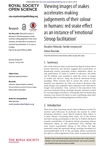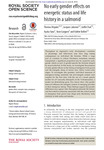Search
Now showing items 1-10 of 49
Viewing images of snakes accelerates making judgements of their colour in humans
(2014)
One of the most prevalent current psychobiological notions about human behaviour and emotion suggests that prioritization of threatening stimuli processing induces deleterious effects on task performance. In order to confirm ...
Discrete but variable structure of animal societies leads to the false perception of a social continuum
(2016)
Animal societies are typically divided into those in which reproduction within a group is monopolized by a single female versus those in which it is shared among multiple females. It remains controversial, however, whether ...
No early gender effects on energetic status and life history in a salmonid
(2015)
Throughout an organism’s early development, variations in physiology and behaviours may have long lasting consequences on individual life histories. While a large part of variation in critical life-history transitions ...
Teaching in hunter– gatherer infancy
(2016)
A debate exists as to whether teaching is part of human nature and central to understanding culture or whether it is a recent invention of Western, Educated, Industrial, Rich, Democratic cultures. Some social–cultural ...
Omura’s whales off northwest Madagascar
(2015)
The Omura’s whale (Balaenoptera omurai)was describedas a new species in 2003 and then soon after as an ancient lineage basal to a Bryde’s/sei whale clade. Currently known only from whaling and stranding specimens primarily ...
Receiving of emotional signal of pain from conspecifics in laboratory rats
(2015)
Though recent studies have shown that rodents express emotions with their face, whether emotional expression in rodents has a communicative function between conspecifics is still unclear. Here, we demonstrate the ability ...
New evidence on the tool assisted hunting exhibited by chimpanzees
(2015)
For anthropologists, meat eating by primates like chimpanzees (Pan troglodytes) warrants examination given the emphasis on hunting in human evolutionary history. As referential models, apes provide insight into the evolution ...
Competition and cooperationina synchronous bushcricket chorus
(The Royal Society, 2014)
Synchronous signalling within choruses of the same species either emerges from cooperation or competition. In our study on the katydid Mecopoda elongata, we aim to identify mechanisms driving evolution towards synchrony. ...
High atmospheric temperatures and ‘ambient incubation’ drive embryonic development and lead to earlier hatching in a passerine bird
(The Royal Society, 2016)
Tropical and subtropical species typically experience relatively high atmospheric temperatures during reproduction, and are subject to climate-related challenges that are largely unexplored, relative to more extensive work ...
Males migrate farther than females in a differential migrant: an examination of the fasting endurance hypothesis
(The Royal Society, 2014)
Patterns of migration including connectivity between breeding and non-breeding populations and intraspecific variation in the distance travelled are important to study because they can affect individual fitness and population ...










